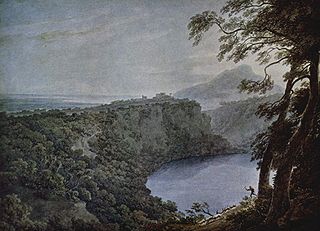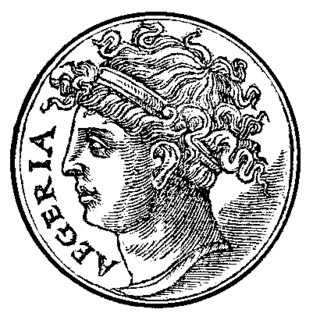Aricini, the ancient inhabitants of Aricia, the form of the name ranking them with the Sidicini, Marrucini, etc., as one of the communities belonging probably to the earlier or Volscian stratum of population on the west side of Italy, who were absorbed by the Sabine or Latin immigrants. [1]

Ariccia is a town and comune in the Metropolitan City of Rome, central Italy, 16 miles (25 km) south-east of Rome. It is in the Alban Hills of the Lazio (Latium) region and could be considered an extension of Rome's southeastern suburbs. One of the Castelli Romani towns, Ariccia is located in the regional park known as the "Parco Regionale dei Castelli Romani".
The Sidicini were one of the Italic peoples of ancient Italy. Their territory extended northward from their capital, Teanum Sidicinum, along the valley of the Liri river up to Fregellae, covering around 3,000 square km in total. They were neighbors of the Samnites and Campanians, and allies of the Ausoni and Aurunci. Their language was a part of the Osco-Umbrian linguistic family.
The Marrucini were an Italic tribe that occupied a small strip of territory around the ancient Teate, on the east coast of Abruzzo, Italy, limited by the Aterno and Foro Rivers. Other Marrucinian centers included Ceio, Iterpromium, Civitas Danzica (Rapino), and the port of Aternum (Pescara), shared with the Vestini.
Special interest attaches to this trace of their earlier origin, because of the famous cult of Diana Nemorensis, whose temple in the forest close by Aricia, beside the lacus Nemorensis , was served by "the priest who slew the slayer, and shall himself be slain"; that is to say, the priest, who was called rex Nemorensis, held office only so long as he could defend himself from any stronger rival. This cult, which is unique in Italy, is picturesquely described in the opening chapter of J. G. Frazer's The Golden Bough , where full references will be found. Of these references the most important are, perhaps, Strabo v.3.12; Ovid, Fasti , 263-272; and Suetonius, Caligula 35, whose wording indicates that the old-world custom was dying out in the 1st century AD. It is a reasonable conjecture that this extraordinary relic of barbarism was characteristic of the earlier stratum of the population who presumably called themselves Arici. [1]

Diana Nemorensis, also known as "Diana of the Wood", was an Italic form of the goddess who became Hellenised during the fourth century BC and conflated with Artemis. Her sanctuary was to be found on the northern shore of Lake Nemi beneath the cliffs of the modern city Nemi. This lake is referred to by poets as speculum Dianae – "Diana's Mirror"; by the town of Aricia which was situated about three miles off, at the foot of the Albanus Mons, the Alban Mount, and separated by a steep descent from the lake, which lies in a small crater-like hollow on the mountainside.

Lake Nemi is a small circular volcanic lake in the Lazio region of Italy 30 km (19 mi) south of Rome, taking its name from Nemi, the largest town in the area, that overlooks it from a height.

The Golden Bough: A Study in Comparative Religion is a wide-ranging, comparative study of mythology and religion, written by the Scottish anthropologist Sir James George Frazer. The Golden Bough was first published in two volumes in 1890; in three volumes in 1900; and in twelve volumes in the third edition, published 1906–15. It has also been published in several different one-volume abridgments. The work was aimed at a wide literate audience raised on tales as told in such publications as Thomas Bulfinch's The Age of Fable, or Stories of Gods and Heroes (1855). The influence of The Golden Bough on contemporary European literature and thought was substantial.










